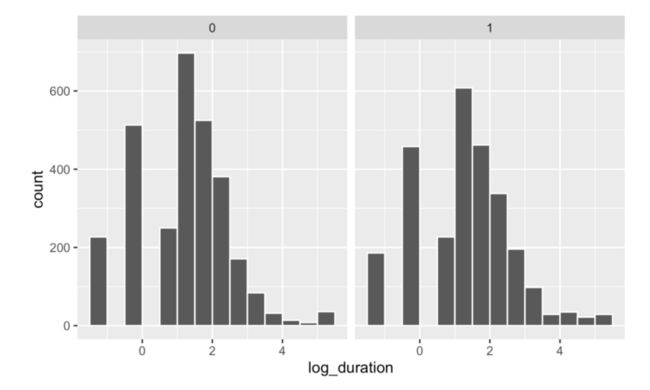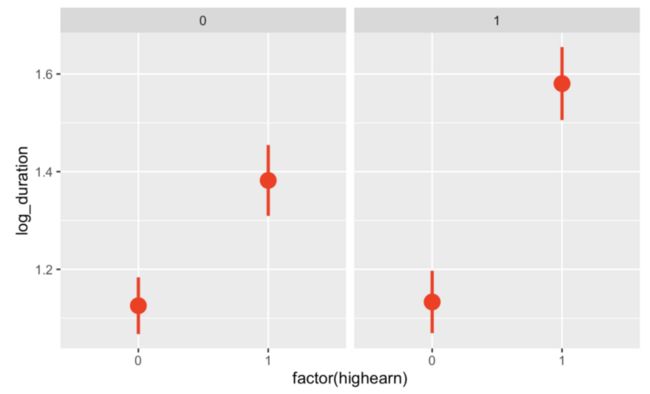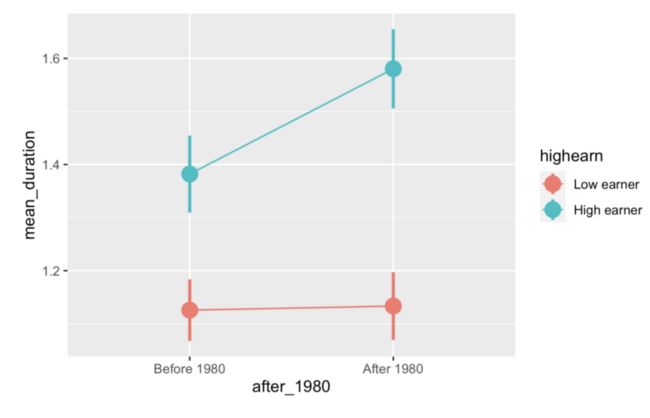1 案例背景
目前 Uber、Netflix 在商业分析中的因果推断常用模型主要是倍差法(Difference in Difference)和匹配(Matching),目前已在其平台中建立相关方法的自主分析工具。这篇文章将介绍倍差法和普通回归法在效应量评估上的真实差异。
这里以一个简单的经济学案例来讲述倍差法 DID 的原理,根据美国联邦法规,每个州的劳工赔偿计划在赔偿受伤的工人时,其赔偿范围从一定的“补偿率”(通常是受伤前工资的三分之二)到某个特定的最高额。对理性决策者而言,继续伤残所能获得的补偿越高,重返工作的动力就越小。
1980年,肯塔基州提高了每周工伤赔偿的最高限额,这里检验赔偿额的变化是否对重返工作的决策有显著影响。我们关心的主要结果变量是 log_duration(在数据中为 ldurat ),或记录的工伤补偿期限(以周为单位)。这里该变量取 log 是因为该变量存在较大的偏差,大多数人失业了几周,而有些人失业了很长时间。制定该政策的目的是使上限增加不会影响低收入工人,但会影响高收入工人,因此我们将低收入工人作为我们的对照组,将高收入工人作为我们的处理组。
数据集包含在 wooldridge R 软件包中的 injury:
- durat(duration):失业救济金的持续时间,以周为单位
- ldurat(log_duration):log(durat)
- after_1980(after_1980):指标变量,观察是在1980年政策更改之前(0)还是之后(1)进行,时间变量:before/after
- highearn:指示变量,用于标记观察值是低(0)还是高(1)收入,分组变量:处理/对照
2 加载和清理数据
首先下载数据集并加载相关库:
library(tidyverse) # ggplot(), %>%, mutate(), and friends
library(broom) # Convert models to data frames
library(scales) # Format numbers with functions like comma(), percent(), and dollar()
library(modelsummary) # Create side-by-side regression tables
# Load the data.
# It'd be a good idea to click on the "injury_raw" object in the Environment
# panel in RStudio to see what the data looks like after you load it
injury_raw <- read_csv("data/injury.csv")
injury <- injury_raw %>%
filter(ky == 1) %>%
# The syntax for rename is `new_name = original_name`
rename(duration = durat, log_duration = ldurat,
after_1980 = afchnge)3 探索性数据分析
首先可以看看高低收入者(对照和处理组)中失业补偿的分布:
ggplot(data = injury, aes(x = duration)) +
# binwidth = 8 makes each column represent 2 months (8 weeks)
# boundary = 0 make it so the 0-8 bar starts at 0 and isn't -4 to 4
geom_histogram(binwidth = 8, color = "white", boundary = 0) +
facet_wrap(vars(highearn))分配情况确实存在偏差,两组中的大多数人都可以享受 0-8 周的福利(还有少数可以享受 180 周以上的福利!这就是 3.5 年!)
如果使用持续时间的对数,则可以得到较少偏斜的分布,该分布更适合回归模型:
ggplot(data = injury, mapping = aes(x = log_duration)) +
geom_histogram(binwidth = 0.5, color = "white", boundary = 0) +
# Uncomment this line if you want to exponentiate the logged values on the
# x-axis. Instead of showing 1, 2, 3, etc., it'll show e^1, e^2, e^3, etc. and
# make the labels more human readable
# scale_x_continuous(labels = trans_format("exp", format = round)) +
facet_wrap(vars(highearn))我们还应该检查政策改变前后的失业情况:
ggplot(data = injury, mapping = aes(x = log_duration)) +
geom_histogram(binwidth = 0.5, color = "white", boundary = 0) +
facet_wrap(vars(after_1980))分布看上去很正常,但很难轻易看出处理前后,即对照组与处理组之间的差异。我们可以绘制平均值。使用 stat_summary() 图层让 ggplot 计算汇总平均值等汇总统计信息。这里我们只计算平均值:
ggplot(injury, aes(x = factor(highearn), y = log_duration)) +
geom_point(size = 0.5, alpha = 0.2) +
stat_summary(geom = "point", fun = "mean", size = 5, color = "red") +
facet_wrap(vars(after_1980))计算平均值和 95% 置信区间:
ggplot(injury, aes(x = factor(highearn), y = log_duration)) +
stat_summary(geom = "pointrange", size = 1, color = "red",
fun.data = "mean_se", fun.args = list(mult = 1.96)) +
facet_wrap(vars(after_1980))可以开始看到经典的差异比较图!看起来 1980 年以后的高收入者平均失业时间更长。在将数据发送到 ggplot 之前,还可以使用 group_by() 和 summarize() 找出分组均值:
ggplot(plot_data, aes(x = after_1980, y = mean_duration, color = highearn)) +
geom_pointrange(aes(ymin = lower, ymax = upper), size = 1) +
# The group = highearn here makes it so the lines go across categories
geom_line(aes(group = highearn))4 倍差法 DID 的计算原理
我们可以通过填写 2x2 来找到对照组和处理组间的真实差异:
diffs <- injury %>%
group_by(after_1980, highearn) %>%
summarize(mean_duration = mean(log_duration),
# Calculate average with regular duration too, just for fun
mean_duration_for_humans = mean(duration))
diffs
## # A tibble: 4 x 4
## # Groups: after_1980 [2]
## after_1980 highearn mean_duration mean_duration_for_humans
##
## 1 0 0 1.13 6.27
## 2 0 1 1.38 11.2
## 3 1 0 1.13 7.04
## 4 1 1 1.58 12.9
before_treatment <- diffs %>%
filter(after_1980 == 0, highearn == 1) %>%
pull(mean_duration)
before_control <- diffs %>%
filter(after_1980 == 0, highearn == 0) %>%
pull(mean_duration)
after_treatment <- diffs %>%
filter(after_1980 == 1, highearn == 1) %>%
pull(mean_duration)
after_control <- diffs %>%
filter(after_1980 == 1, highearn == 0) %>%
pull(mean_duration)
diff_treatment_before_after <- after_treatment - before_treatment
diff_control_before_after <- after_control - before_control
diff_diff <- diff_treatment_before_after - diff_control_before_after
diff_diff
## 0.19 对照组和处理组的差异估计为 0.19,这意味着该政策计划导致失业时间增加 19%。
5 倍差法 DID 回归
像上面的手工计算很繁琐,因此我们可以使用回归来完成!请记住,我们需要包括用于处理/对照组、1980前/后以及两者之间交互作用的指标变量:
系数是我们最终关心的效果,即 DID 估计量。
model_small <- lm(log_duration ~ highearn + after_1980 + highearn * after_1980,data = injury)
tidy(model_small)
## # A tibble: 4 x 5
## term estimate std.error statistic p.value
##
## 1 (Intercept) 1.13 0.0307 36.6 1.62e-263
## 2 highearn 0.256 0.0474 5.41 6.72e-8
## 3 after_1980 0.00766 0.0447 0.171 8.64e-1
## 4 highearn:after_1980 0.191 0.0685 2.78 5.42e-3 highearn:after_1980 的系数应该与我们手动计算的系数相同!它具有统计意义,因此我们可以确信高低收入之间的失业时长存在显著差异。
6 加入控制变量的 DID 回归
DID 回归的优点之一是,可以包括控制变量。例如,与其他行业的工人相比,建筑或制造业工人的工人索赔期限往往更长。我们可能还希望控制工人的人口统计信息,例如性别,婚姻状况和年龄。
让我们用以下附加变量估算基本回归模型:
- male
- married
- age
- hosp (1=住院)
- indust (1=制造商,2=建筑,3=其他)
- injtype (1-8;不同类型伤害的类别)
- lprewage (提出索赔之前的工资记录)
提示:indust 和 injtype 在数据集中以数字(1-3和1-8)表示,但实际上它们是类别。在 R 中必须将它们视为类别(或因子)。
# Convert industry and injury type to categories/factors
injury_fixed <- injury %>%
mutate(indust = as.factor(indust),
injtype = as.factor(injtype))
model_big <- lm(log_duration ~ highearn + after_1980 + highearn * after_1980 +
male + married + age + hosp + indust + injtype + lprewage,
data = injury_fixed)
tidy(model_big)
# Extract just the diff-in-diff estimate
diff_diff_controls <- tidy(model_big) %>%
filter(term == "highearn:after_1980") %>%
pull(estimate)
modelsummary(list("DID" = model_small, "DID+control" = model_big))| DID | DID+control | |
|---|---|---|
| (Intercept) | 1.126*** | -1.528*** |
| (0.031) | (0.422) | |
| highearn | 0.256*** | -0.152* |
| (0.047) | (0.089) | |
| after\_1980 | 0.008 | 0.050 |
| (0.045) | (0.041) | |
| highearn × after\_1980 | 0.191*** | 0.169*** |
| (0.069) | (0.064) | |
| male | -0.084** | |
| (0.042) | ||
| married | 0.057 | |
| (0.037) | ||
| age | 0.007*** | |
| (0.001) | ||
| hosp | 1.130*** | |
| (0.037) | ||
| indust2 | 0.184*** | |
| (0.054) | ||
| indust3 | 0.163*** | |
| (0.038) | ||
| injtype2 | 0.935*** | |
| (0.144) | ||
| injtype3 | 0.635*** | |
| (0.085) | ||
| injtype4 | 0.555*** | |
| (0.093) | ||
| injtype5 | 0.641*** | |
| (0.085) | ||
| injtype6 | 0.615*** | |
| (0.086) | ||
| injtype7 | 0.991*** | |
| (0.191) | ||
| injtype8 | 0.434*** | |
| (0.119) | ||
| lprewage | 0.284*** | |
| (0.080) | ||
| Num.Obs. | 5626 | 5347 |
| R2 | 0.021 | 0.190 |
| R2 Adj. | 0.020 | 0.187 |
* p \< 0.1, ** p \< 0.05, *** p \< 0.01
在控制了许多人口统计因素之后,“差异比较”估计值变小(0.169),表明该政策导致工作场所受伤后的失业时间延长了16.9%。之所以较小,是因为其他自变量可以解释的部分log_duration的变化。
其余文章阅读请移步公众h:DataGo数据狗
本文由博客群发一文多发等运营工具平台 OpenWrite 发布






